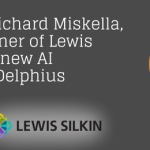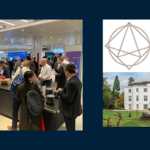When it comes to the business of law and the technology that law firms rely on to operate, blockchain has until very recently been of limited relevance, with CIOs and their teams only interested at the very fringes – the majority will tell you off the bat that blockchain is massively overhyped, and to a great extent they are right.
But in contrast with the fact that blockchain in 2018 officially entered the trough of disillusionment (according to Gartner), there are several very good practical reasons why in 2019 it should be on everyone’s radar.
Integrations
At its very simplest, blockchain means that a set of facts, such as in a contract, can be recorded (encrypted) on a distributed ledger and can’t be altered unilaterally.
As you’ll have read elsewhere, there are different types of blockchain infrastructure – public and private – and in the latter camp sits Integra Ledger, the company that founded the Global Legal Blockchain Consortium and the technology that underpins recent integrations with both Thomson Reuters Contract Express and NetDocuments.
It is through these integrations – one of which is at proof of concept stage and the other now in beta in the United States – that lawyers will shortly be able to encrypt their documents via blockchain technology.
 He may be optimistic, but Integra Ledger’s founder David Fisher (pictured right) tells us: “By the end of this year all the major applications in law will be integrated and that means the majority of lawyers by end of the year will be using blockchain and won’t even know it.”
He may be optimistic, but Integra Ledger’s founder David Fisher (pictured right) tells us: “By the end of this year all the major applications in law will be integrated and that means the majority of lawyers by end of the year will be using blockchain and won’t even know it.”
Thomson Reuters Contract Express
The integration with Contract Express and NetDocuments came about because Integra’s CTO David Berger thought about what technology across the legal technology landscape Integra needed to integrate with if it’s to be the platform for document exchange and version control – the fabric for digital documents.
They first identified NetDocuments (see below for more detail about that integration), and then document assembly.
 Andy Wishart (pictured left), global head of drafting and automation at Thomson Reuters, says: “They were super proactive. David Berger signed up for a trial of Contract Express online. When he had signed up, he was able to download our API and just got to work. He read the API and built a template and proof of concept against our API, then created a video and sent it to me, saying ‘we should talk’. I just loved the proactive nature of that – I love how it tells a great story of how far we’ve come from an API perspective at Contract Express. Immediately we got engaged and refined the proof of concept, which we used as the basis for Thomson Reuters to become a member of GLBC and used that as the first area of integration between TR and Integra.”
Andy Wishart (pictured left), global head of drafting and automation at Thomson Reuters, says: “They were super proactive. David Berger signed up for a trial of Contract Express online. When he had signed up, he was able to download our API and just got to work. He read the API and built a template and proof of concept against our API, then created a video and sent it to me, saying ‘we should talk’. I just loved the proactive nature of that – I love how it tells a great story of how far we’ve come from an API perspective at Contract Express. Immediately we got engaged and refined the proof of concept, which we used as the basis for Thomson Reuters to become a member of GLBC and used that as the first area of integration between TR and Integra.”
About blockchain more generally, Wishart says: “Blockchain is really good at tracking assets and the identification of a document. So, we refer to what Integra would do as documentary proof of existence: there is a record on the blockchain that’s immutable that says this document existed at one time in the past.
“How they have weaved it into Contract Express is that once a document is created in Contract Express and is finalised, we can create a reference of that on the Integra blockchain by creating a unique reference or thumbprint. Integra stores the thumbprint but also the data that was used to create that document. So, imagine the document was a lease agreement. Alongside the thumbprint we might store the rent amount, the parties, the address and the permit of use of the premise – we store that rich data on the blockchain. What that enables us to do in the future is at the point of time when some form of event is to happen like a rent payment or a termination or an assignment, we can go back to the blockchain and look up the data and write more records attached to the block so that there is an immutable audit.”
While that may suggest easier analytics Wishart says: “Yes, a number of companies are looking at how you draw analytics out of blockchain; I’m not sure it’s any easier than if the information is stored within in a regular database. It’s more about having a record of the contract and the data related to it that no single party has complete control of. It’s decentralised. The landlord can’t say ‘I’ve no record of that contract – it’s publicly available.”
One of the potential concerns around private blockchain is which would be the definitive blockchain were there to be a number of consortia creating a platform and fighting for dominance, but Wishart says: “We’re so far away from that and Integra has done a great job in creating momentum and getting law firms to sign up to the consortium. The consortium members are really interested to hear how Integra will evolve, but it’s early days.”
He adds: “The use cases that have been identified around document proof of existence have a place to play in legal. I’m not surprised that big companies like NetDocuments are putting in significant time and resources.”
While Wishart thinks that Fisher’s prediction of a year for full vendor integration is ambitious, he agrees that it is through vendor integration that blockchain will gain widespread adoption.
“David thinks that users and those practising law should not be aware that what they are producing is being stored on the blockchain. “I don’t think lawyers care so much about what is under the hood but what is the benefit. If there is a benefit to the exchange of information between law firm and client and other lawyers, then that’s a good thing. But the end user shouldn’t know the technology is there – it should be just a core part of how a law firm works, much like the document management system,” he says.
Thomson Reuters integration is still at proof of concept stage, with Wishart and the team exploring different use cases with clients. He says: “We’ve had positive feedback from those law firms actively engaged in the blockchain community but haven’t gone deep with most firms.”
 NetDocuments integration
NetDocuments integration
While speaking to Wishart helps to explain the genesis of the two main legal technology integrations, NetDocuments is further along the track and VP of product strategy Peter Buck (pictured right) says: “We’ve proved it works and does e-signatures and now we’re releasing it with a customer in the later part of this year in the context of deal binders and closing sets. You and I may be buying a company and the 50 documents will be registered on the blockchain.”
Specifically, the integration means that documents finalised within deal management platform Closing Room, which NetDocuments acquired from Chapman and Cutler in November 2018, can be stored on the blockchain.
Buck said: “There are four organisations working with us. One is a corporate and one is their outside counsel. We’ve partnered with those two to drive beta adoption in the corporate and deal binder space on that basis.
“This is the starting point,” he adds. “It sets the baseline and we can see if it works and might go down the email attachment encryption route. So, you send me an attachment that’s not encrypted and when you send the attachment, I’d like to encrypt it so that only I can read it but there’s a secret you have to open – that secret we put on the blockchain.”
He agrees with Wishart that lawyers don’t need to know about the underlying technology, commenting: “People don’t care about how email gets from A to B.
“Blockchain will see the emergence of standards and vendors adopting protocols so you won’t care. It will replace digital signatures – we will be able to use blockchain to establish that trust.”
Trust is at the very core of blockchain’s existence and Buck says: “Right now, when I share things with you, you know me so you can call and say, ‘what you sent is wrong’ and we can negotiate and get the right thing. But if parties don’t trust each other we need a mechanism to establish that trust – the connective tissue between organisations who are not on the same wavelength.”
While CIOs are being asked by their transactional teams to explain blockchain to clients, their direct exposure so far is limited and Buck says that blockchain also has an image problem, commenting: “Blockchain was first used over cryptocurrency – that casts a huge shadow over blockchain.”
But he adds: “If we have this conversation 10 months from now it will be different; we’re on the really early edge of the curve – we’re putting the plumbing together and then people will want to use it.”
So, does Buck agree with Fisher that by the end of this year all legal tech applications will have blockchain integrations? He doesn’t, and says: “Remember email – it was essentially a hobby product for five year and took three years to move from hobby to reality.”
But his estimate isn’t so far away either. “Last year was scepticism. This year awareness. Next year adoption.”










